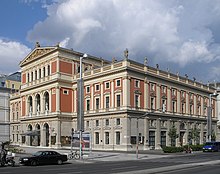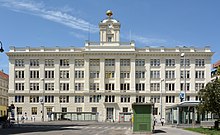Line of two
Zweierlinie , also [former] 2er-Linie , exclusively until 1910, becoming rarer after 1960 Ladenstraße , is the colloquial name for a street in the center of Vienna , which runs parallel to the Ringstraße outside of Vienna . The name comes from the tram lines with the additional number 2 that once ran in this street . Today, the U2 underground line partly runs under the street.
Location in the city area
From a historical perspective, the street runs from Hinteren Zollamtsstraße (near the Danube Canal ) in the 3rd district, east of the old town, via Invalidenstraße, Am Heumarkt and Lothringerstraße to Karlsplatz south of the old town and from there to Alser Straße / Universitätsstraße in the northwest, always in a distance of about 200 to 400 meters out of town parallel to the ring. It was built on the outer edge of the field of fire known as the glacis when the city wall was removed from 1858, roughly at the same time as the ring road that was laid out in the central area of the former glacis. The freight road at that time was used to carry loads.
Today, the Karlsplatz – Alser Straße / Universitätsstraße section in particular is referred to as a double line, and occasionally the section from Lothringerstraße via Karlsplatz to Alser Straße / Universitätsstraße.
The central edge of the street to the north forms the boundary between the 1st district and districts 6, 7 and 8 from the corner of Getreidemarkt / Gauermanngasse to the corner of Landesgerichtsstraße / Universitätsstraße .
Public transport

The construction of the tram on the later double line took place in stages:
- 1899 in Invalidenstraße from Landstraßer Hauptstraße to Ungargasse (as part of a connection to the Südbahnhof ),
- 1900 in the Hinteren Zollamtsstraße and the Invalidenstraße north of the Landstraßer Hauptstraße,
- 1901 from Getreidemarkt / Friedrichstrasse to Landesgerichtsstrasse,
- In 1902 the missing link from Am Heumarkt via Johannesgasse, Lothringerstraße and Karlsplatz to Friedrichstraße / Getreidemarkt.
The name "Zweierlinie" is derived from the fact that the through lines with index 2 have been running on the route here in the Vienna tram network since 1907.
The following lines ran here (the ones in bold ran the longest and contributed intensively to the consolidation of the term two-line in the Viennese community; they ran, among other things, on today's two-line in the narrower sense):
- 1910–1980: H 2 , Hernals , Wattgasse– Prater , Hauptallee
- 1911–1932: J 2 , Schottenhof [= 16., Erdbrustgasse] –Radetzkystraße
- 1911–1919: R 2 , Mauer - Praterstern
- 1918: O 2 , Praterstern – Südbahnhof
- 1924–1980: E 2 , Gersthof , Herbeckstrasse – Praterstern
- 1925–1927: S 2 , Grinzing –Prater (star)
- 1928–1980: G 2 , Hohe Warte – Praterstern
In the scheme introduced in 1907, line signals made up of individual letters denoted so-called through lines, which not only ran on radial routes (periphery - city center), but also in the city center on the ring and / or Franz-Josefs-Kai or on the double line, an arc of a circle, more rarely a whole circle, around the old town. (This still applies to line D today.) With the subscript two as an addition, it was made clear to passengers that these lines did not run on the ring road.
The two-way lines ran from Heumarkt to Landesgerichtsstrasse mostly on their own track. From 1966 to 1980, the three lines from the Secession (Friedrichstrasse, Getreidemarkt) at Karlsplatz were run northwards as USTRABA (Unterpflaster-Straßenbahn) in a tunnel just below the road surface in order to gain more space for individual traffic on the surface .
In 1980 the tunnel was adapted and has since been used by the U2 underground line, which has the Museumsquartier , Volkstheater and Rathaus stations on the double line . The Lerchenfelder Straße station was closed because the distance to the Volkstheater station was too short when the line was adapted for long underground trains in 2003.
Since 1981, the section Hintere Zollamtsstraße – Invalidenstraße of the historical double line in the 3rd district has been used by line O, but no connection to the history of the line is made here and the subscript double is not used.
On Lothringerstrasse, the remainder of the historic two-way line is a track connection from Schwarzenbergplatz to Karlsplatz with a loop at the historic Stadtbahn pavilions . This connection is used for special trips, often with cars from the transport museum Remise . Since 1966 and 1980 there have been no tram tracks on most of the historic two-way line.
Private transport
The street, then unofficially known as the “outer ring road” or “freight road”, was created in the 1860s as part of the construction of the ring road in order to be able to keep the transport of loads away from the prestigious boulevard: trucks have always been banned on the ring. Although private transport has increased very strongly since the 1960s, the unofficial designation two-way line, which comes from public transport, has become established for part of the historic street.
Since the ring is now a one-way clockwise, the carriageway out of town of the two-way line (driving south) also represents a "counter-ring" in the other direction. The two-way line can be driven in both directions, has partially structurally separate carriageways and is now for the individual traffic in the city center of great importance.
If the ring road is closed due to major events or demonstration trains, the diversion takes place via the two-way line. A parking lane for tourist buses will be set up on the two-way line on Advent weekends .
Subdivision and important structures
(Only the section from the city park to the west or north is shown here, which today is mainly referred to as the two-line line.)
- U-Bahn station Stadtpark (U4) by Otto Wagner , 3., Johannesgasse
Lothringerstraße
From 1st / 3rd, Johannesgasse, to 1st / 4th, Karlsplatz
- Hotel Inter-Continental, opened in 1964
- Beethoven Monument , Beethovenplatz
- Wiener Eislaufverein (outdoor ice rink)
- Academic high school , Beethovenplatz
- Wiener Konzerthaus
- Akademietheater , the second building of the Burgtheater
- House of Industry , Schwarzenbergplatz 4
- Georg Raphael Donner monument
Karlsplatz
From 1., Lothringerstrasse, to 1., Friedrichstrasse
- Wiener Musikverein
- Vienna Museum
- Karlskirche , to be seen from the double line on the other side of the Resselpark
- Künstlerhaus with Albertina Modern , Theater brut and city cinema in the Künstlerhaus
- Karlsplatz underground station (U1, U2, U4) with historic light rail pavilions by Otto Wagner
- Vienna University of Technology , historic main building, can be seen beyond the Resselpark
- Crossing Kärntner Straße / Wiedner Hauptstraße with tram lines 1 and 62 as well as the local railway Vienna – Baden
- Kunsthalle Wien Project Space
- Alexander Girardi Monument
- Café Museum (corner of Operngasse)
- Entry point for guided tours in the sewer network , Esperantopark
Grain market
From 1., Karlsplatz / Friedrichstraße, to 1., Babenbergerstraße / 6., Mariahilfer Straße
- Secession between the two lanes
- Marc Anton Monument
- Academy of Fine Arts Vienna (back)
- Former Genie administrative building and chemistry high-rise building of Technical University
- “Palais Eschenbach”, building of the Austrian Trade Association and the Austrian Association of Engineers and Architects (historically not a palace), built in 1872 by Otto Thienemann on the corner of Eschenbachgasse
Museum Square
From 1., Babenbergerstraße / 7., Mariahilfer Straße, to 1., Bellariastraße / 7., Burggasse
- Museumsquartier underground station
- Kunsthistorisches Museum Vienna
-
MuseumsQuartier
- Zoom Children's Museum
- Jungle children's theater
- Leopold Museum
- Tanzquartier Vienna
- District 21
- Halls E and G
- Kunsthalle Vienna
- Museum of modern art
- Architekturzentrum Wien
- Maria-Theresien-Platz with the monument to the Empress
- Natural History Museum Vienna
Museumstrasse
From 1., Bellariastraße / 7th, Arthur-Schnitzler-Platz, Burggasse, to 1., Schmerlingplatz / 7th, Lerchenfelder Straße
- Volkstheater underground station
- Volkstheater on Arthur-Schnitzler-Platz
- Hansi-Niese monument
- Ferdinand Raimund Monument
- Palace of Justice
- Palais Trautson (moved away from the street)
- Former Lerchenfelder Straße underground station
Auerspergstrasse
From 1., Schmerlingplatz / 8., Lerchenfelder Straße, to 1., Stadiongasse / 8., Josefstädter Straße
- Auersperg Palace
- Former Sanatorium Auersperg, built in 1907/1908 by Robert Oerley , place of death of the painter John Quincy Adams , 1964 student residence, since 2008 Hotel "Levante Parliament"
- Corner of Stadiongasse: 1954–1973 Forumkino , at that time the largest in the city, recently added to for offices; Replaced from 1976–1980 by the municipal authority's data center , which was demolished in 2017/2018 for a new building.
Landesgerichtstrasse
From 1., Stadiongasse / 8., Josefstädter Straße, to 1., Universitätsstraße / 9., Frankhplatz ( Alser Straße ), interrupted by Friedrich-Schmidt-Platz
- Café Eiles (corner of Josefstädter Straße)
Friedrich-Schmidt-Platz
From 1., Lichtenfelsgasse / 8., Loidoldgasse, to 1., Felderstraße / 8., between Tulpen- and Florianigasse
- No. 3: Former Military Geography Institute
- In front of No. 3 and 4: Rathaus subway station , exits
- No. 4: Former Palais Czernin , until 1954 location of the Czernin picture gallery
- No. 1: City Hall , back with access to the information office
- No. 5: Culture Department of the City of Vienna
- Nos. 8 and 9: Wiener Planungswerkstatt (exhibition rooms of the city planning department of the City of Vienna) in the former Palais Obentraut
Landesgerichtstrasse
(see above)
Due to the large street width, this house forms the visual end of the Landesgerichtsstraße:
literature
- Two lines in the Vienna History Wiki of the City of Vienna
- Heinz Fink: The 2 line. Vienna's second boulevard. Vienna 1998
Web links
- Historical images (Hungarian)
- Nice second row - the moth over the line of two.
Individual evidence
- ↑ Wolfgang Kaiser: Remarkable fragments in Vienna. The Unterpflasterstrassenbahn in Vienna , part 2, in: Strassenbahn Magazin , GeraMond-Verlag, Munich, edition 9/09, pp. 68–75
- ^ Felix Czeike : Historical Lexicon Vienna. Volume 3: Ha-La. Kremayr & Scheriau, Vienna 1994, ISBN 3-218-00545-0 , p. 689.
- ↑ Page no longer available , search in web archives: Erich Vorrath in 24 hours for Vienna , online customer magazine of Wiener Stadtwerke, No. 212 / November 2010
- ^ Joseph Gepp: Beautiful second row , in the weekly magazine Falter , Vienna, No. 6 / February 4, 2009
- ^ Walter Krobot, Josef Otto Slezak, Hans Sternhart: Tram in Vienna - the day before yesterday and the day after tomorrow , Verlag Josef Otto Slezak, Vienna 1972, ISBN 3-900134-00-6 , p. 300 f.
- ↑ Helmut Portele: Collection “Wiener Tramwaymuseum” , self-published, Vienna 2009, ISBN 978-3-200-01562-3 , p. 960 f.
- ↑ City of Vienna bus concept. Retrieved September 20, 2016 .
Coordinates: 48 ° 12 ′ 46.9 ″ N , 16 ° 21 ′ 21.5 ″ E










